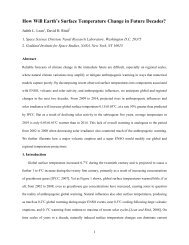University of California - Leif and Vera Svalgaard's
University of California - Leif and Vera Svalgaard's
University of California - Leif and Vera Svalgaard's
- No tags were found...
Create successful ePaper yourself
Turn your PDF publications into a flip-book with our unique Google optimized e-Paper software.
356 C.O. Lee et al.Figure 14 Global outward mapping <strong>of</strong> coronal holes supplying the solar wind for CR 1898 during theSC 22 period. (Top panel) Open (color dotted areas) <strong>and</strong> closed (areas with blue – red field lines) field regionsbelow 1.25R ⊙ . (Second panel) The photospheric sources mapped out to the source surface at 2.5R ⊙ .Thetwosolid gray bars mark the ecliptic plane location (between ±7.25° latitudes). The thick blue curve near the top<strong>of</strong> the panel marks the projected Ulysses trajectory. (Third panel) The WSA model predictions <strong>of</strong> the coronalhole areas <strong>and</strong> the solar wind speeds arising from them. (Bottom panel) The magnetic field magnitude at 1 AUmodeled by the coupled MAS/ENLIL solar wind model. The black curve seen throughout is the magneticneutral line.a broad longitude range within the ecliptic plane (between ±7.25° latitudes) as indicatedby the two solid gray bars. Other Carrington rotations from the SC 22 period <strong>of</strong> our studyalso show similar features, where the open fields from the PCHs have very wide latitudinalextents at the source surface <strong>and</strong> the isolated <strong>and</strong> PCH-extension regions <strong>of</strong> open fieldshave a moderate to narrow latitudinal range. This is consistent with the Ulysses results <strong>of</strong>McComas et al. (2008), who showed that the b<strong>and</strong> <strong>of</strong> solar wind variability was narrow<strong>and</strong> confined to low latitudes during this period. The solid blue curve near the top <strong>of</strong> this




![When the Heliospheric Current Sheet [Figure 1] - Leif and Vera ...](https://img.yumpu.com/51383897/1/190x245/when-the-heliospheric-current-sheet-figure-1-leif-and-vera-.jpg?quality=85)

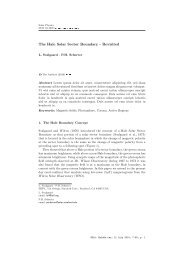

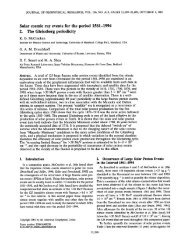
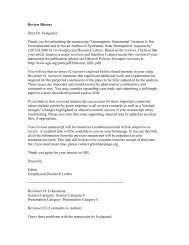

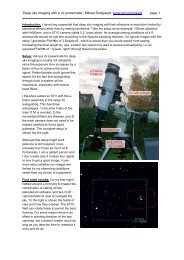
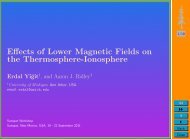
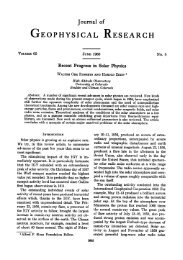
![The sum of two COSine waves is equal to [twice] the product of two ...](https://img.yumpu.com/32653111/1/190x245/the-sum-of-two-cosine-waves-is-equal-to-twice-the-product-of-two-.jpg?quality=85)
